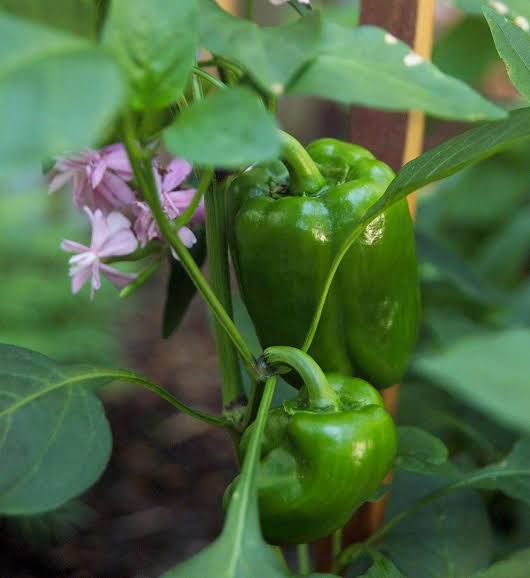If you love adding a little color and spice to your meals, growing your own peppers is one of the most rewarding gardening projects you can do! Whether you prefer sweet bell peppers or fiery hot chili varieties, this guide will show you exactly how to plant peppers successfully from seeds to harvest.With just a few simple steps, you can enjoy homegrown peppers bursting with flavor — and you don’t need a huge garden to do it. Let’s dive into everything you need to know and try this amazing how to plant peppers idea for a garden that thrives with vibrant colors and delicious produce.🌱 Introduction: Why Grow Peppers at Home?Peppers are among the easiest and most satisfying plants to grow. They thrive in pots, raised beds, or directly in the ground — perfect for small spaces or large gardens alike.Homegrown peppers taste fresher, look brighter, and are packed with more vitamins than store-bought ones. Plus, you can choose from countless varieties — from sweet red bell peppers to smoky jalapeños or blazing habaneros.So, if you’re ready to add flavor and flair to your garden, it’s time to try this amazing how to plant peppers idea and bring some heat (or sweetness) to your backyard!🫑 Step 1: Choose the Right Pepper VarietyBefore you start planting, decide which type of pepper suits your taste and climate.🌶️ Popular Pepper Varieties:Bell Peppers (Sweet Peppers): Mild, colorful, and perfect for salads or stuffing.Jalapeños: Medium heat; great for salsas and grilling.Cayenne: Thin and spicy; ideal for drying or making chili powder.Banana Peppers: Tangy and mild; delicious pickled.Habaneros: Very hot; perfect for those who love fiery dishes.👉 Tip: If you live in a cooler climate, look for early-maturing or compact varieties that perform well in containers.🌿 Step 2: Start Seeds IndoorsPeppers love warmth and need time to grow. For best results, start your seeds indoors 8–10 weeks before the last frost date.How to Start Pepper Seeds:Fill small seed trays or pots with seed-starting mix (light and well-draining).Plant seeds about ¼ inch deep and lightly cover with soil.Mist the soil to keep it moist, not soggy.Place the trays in a warm location (75–85°F / 24–29°C) — near a sunny window or on a heating mat.Keep humidity high by covering with plastic wrap or a dome lid.🌱 Germination Time: 7–21 days, depending on the variety and temperature.Once seedlings sprout, remove the cover and move them to a sunny spot (or use grow lights for 14–16 hours a day).🌞 Step 3: Transplant Seedlings OutdoorsWhen the danger of frost has passed and night temperatures stay above 55°F (13°C), it’s time to move your pepper seedlings outdoors.Steps for Transplanting:Harden off seedlings: Gradually expose them to outdoor conditions for 7–10 days before transplanting.Choose a sunny location with at least 6–8 hours of sunlight daily.Ensure soil is warm, rich, and well-draining (loamy soil with compost is ideal).Plant seedlings 18–24 inches apart in rows about 24–30 inches apart.Water thoroughly after planting.👉 Pro Tip: Adding a layer of mulch helps retain moisture and keeps weeds away.💧 Step 4: Watering and Feeding Your Pepper PlantsPeppers love consistency — especially when it comes to water and nutrients.Watering Tips:Keep the soil evenly moist, but avoid overwatering.Water deeply 1–2 times a week, depending on weather conditions.Use drip irrigation or soaker hoses to avoid wetting the leaves (which can cause diseases).Feeding Tips:Use a balanced fertilizer (10-10-10) or organic compost every 3–4 weeks.Once flowers appear, switch to a fertilizer higher in potassium and phosphorus for better fruiting.🌸 Step 5: Encourage Flowering and Fruit ProductionHealthy pepper plants produce plenty of blossoms — but not all will turn into fruits unless pollination occurs.How to Boost Pollination:Plant flowers nearby to attract bees and pollinators.Gently shake or tap flowers to help transfer pollen (if growing indoors).Avoid over-fertilizing with nitrogen; it causes leafy growth but fewer fruits.As fruits develop, you’ll see green peppers first — which can be harvested at this stage or left to ripen into red, orange, or yellow depending on the variety.🍽️ Step 6: Harvesting PeppersTiming is key when harvesting peppers!When to Harvest:Green Bell Peppers: 60–80 days after transplanting.Colored Peppers: 80–100 days, depending on the variety.Hot Peppers: Wait until they reach their full color for maximum heat.Use pruning shears or scissors to cut peppers from the plant, leaving a small stem attached to avoid damaging the plant.🌻 Step 7: Troubleshooting Common Pepper ProblemsEven the best gardeners face challenges — here’s how to handle the most common pepper issues.🪲 Pests:Aphids, spider mites, and whiteflies are common. Spray with insecticidal soap or neem oil.🍂 Yellow Leaves:Often caused by overwatering or poor drainage. Check soil moisture and improve airflow.🌶️ Blossom Drop:Can happen due to temperature extremes. Peppers prefer 70–85°F (21–29°C) days and 60–70°F (15–21°C) nights.💡 Practical Tips for Growing the Best PeppersRotate crops yearly to avoid soil-borne diseases.Pinch early flowers to encourage stronger root and leaf growth.Use raised beds or containers in cooler regions for warmer soil.Add Epsom salt (magnesium sulfate) occasionally — it promotes greener leaves and better yields.Stake taller plants to support heavy fruit loads.🌶️ Fun Varieties to Try in Your GardenMini Bell Peppers – Sweet, colorful, and perfect for snacks.Poblano Peppers – Mild heat, great for stuffing or roasting.Thai Chili Peppers – Compact and very spicy, perfect for pots.Shishito Peppers – Mild and delicious pan-fried with olive oil.No matter your taste preference, growing your own peppers gives you endless flavor possibilities — and a fun gardening experience!🌞 Conclusion: Try This Amazing How to Plant Peppers Idea!With these easy steps, you now know exactly how to plant peppers and grow them like a pro. From tiny seeds to bright, flavorful fruits, the process is simple, satisfying, and totally worth it.Whether you grow them in containers on your balcony or in a backyard garden bed, peppers reward you with color, flavor, and freshness that store-bought ones can’t match. So grab your seeds, prepare your soil, and try this amazing how to plant peppers idea today — your taste buds will thank you later! 🌶️💚

